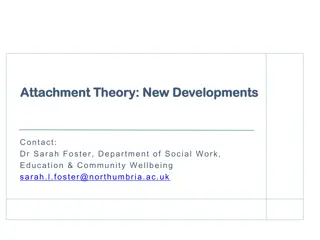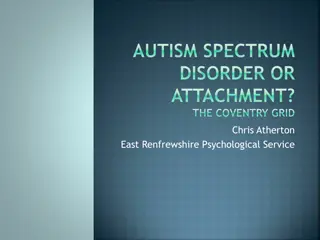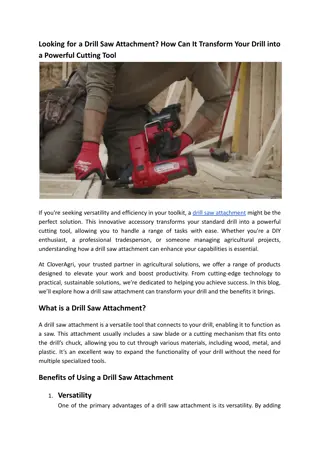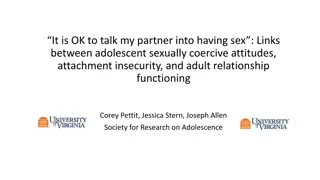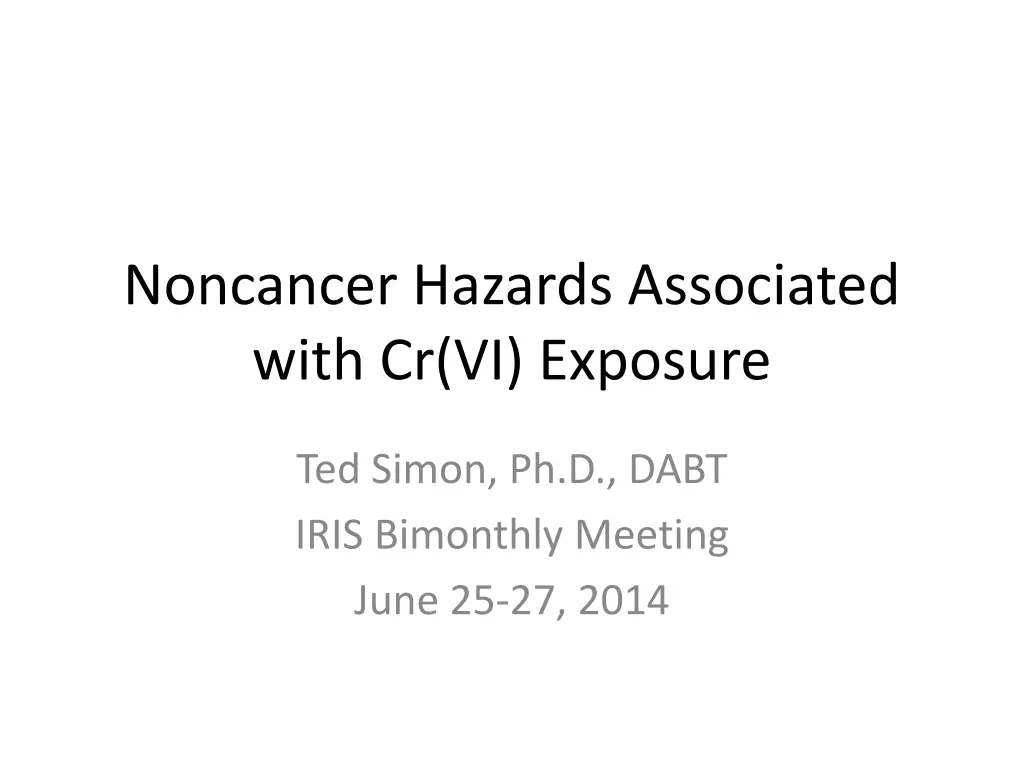
Hazards Associated with Cr(VI) Exposure - Noncancer Endpoints
Explore the noncancer hazards associated with Cr(VI) exposure, focusing on critical endpoints and the classification of NOAELs and LOAELs. The array of potential noncancer endpoints, such as liver toxicity and gastrointestinal effects, is discussed in detail with specific examples and doses. Understand the implications of different endpoints on health outcomes and risk assessment.
Download Presentation

Please find below an Image/Link to download the presentation.
The content on the website is provided AS IS for your information and personal use only. It may not be sold, licensed, or shared on other websites without obtaining consent from the author. If you encounter any issues during the download, it is possible that the publisher has removed the file from their server.
You are allowed to download the files provided on this website for personal or commercial use, subject to the condition that they are used lawfully. All files are the property of their respective owners.
The content on the website is provided AS IS for your information and personal use only. It may not be sold, licensed, or shared on other websites without obtaining consent from the author.
E N D
Presentation Transcript
Noncancer Hazards Associated with Cr(VI) Exposure Ted Simon, Ph.D., DABT IRIS Bimonthly Meeting June 25-27, 2014
Noncancer Endpoints Choosing the critical endpoint means that the POD and resulting RfD will be protective of other endpoints What is the critical noncancer endpoint? Arrays of NOAELs and LOAELs
Array of NOAELs and LOAELs ? Endpoint? Classification? NOAEL?/? BMDL10? Specific?Endpoint? Basophilic? focus? in? male? rats? (NTP,? 2008)? Specific?Endpoint? Chronic? inflammation? in? female? rats? (NTP,? 2008)? Histiocytic? inflammation? of? abdominal? lymph? nodes? in? male? and? female? mice? (NTP,? 2008)? Changes? in? hematocrit,? MCV,? and? hemoglobin? (NTP,? 2008)? LOAEL? 0.21? /? NA? 0.24? Liver? Toxicity? Potential? immune? /? inflammatory? changes? Histiocytic? inflammation? of? abdominal? lymph? nodes? in? male? rats? ? (NTP,? 2008)? Changes? in? hematocrit,? MCV,? and? hemoglobin? in? rats? (NTP,? 2008)? Diffuse? Epithelial? Hyperplasia,? small? intestine,? male? and? female? mice? (NTP,? 2008)? Micronuclei? in? RBCs? of? bone? marrow? and? fetuses? of? mice? (De? Flora? et? al.,? 2006)? Changes? in? male? reproductive? function? in? monkeys? (Subramanian? et? al.,? 2006)? A? range? of? endpoints? in? F? Swiss? albino? rats? (Kanojia? et? al.,? 1996)? 0.21? /? NA? 0.38? 0.21? /? NA? NA? Hematotoxicity? Diffuse? Epithelial? Hyperplasia,? small? intestine,? male? and? female? mice? 0.38?/?0.09? 0.38? Gastrointestinal? Toxicity? brain? DNA? single-strand? breaks? in? female? rats? (Bagchi? et? al.,? 1997? 0.91? /? NA? 1? ? Genotoxicity? ? Change? is? male? reproductive? function? in? rabbits? (Yousef? et? al.,? 2006)? 4.4? /? NA? 3.6? /? NA? Reproductive? Toxicity? Adverse? changes? in? fetal? development? in? rats? (Elsaieed? and? Nada,? 2002)? Renal? lesions? in? male? rats? Developmental? Toxicity? 31? 8.4? NA? 1? Kidney? toxicity? Renal? lesions? ?
Liver Toxicity PODs as an Process Example ? Study? Sex/Lifestage/ Strain/Species? Specific?Endpoint? Doses?(mg/kg/d?Cr6)? NOAEL? LOAEL? Potential?MOA?Considerations? ? NTP,? 2008? Associated? with? inflammation,? likely? due? to? tissue? damage? in? the? small? intestine? and? possibly? lymph? nodes? and? liver.? Possible? oxidative? stress? at? higher? doses.? Possibly? due? to? release? of? cytokines? from? damaged? intestinal? tissue.? Possible? oxidative? stress? at? higher? doses.? Likely? reflects? migration? of? immune? cells? as? part? of? the? inflammatory? process.? Possible? oxidative? stress? at? higher? doses.? Basophilic? foci? 0,? 0.21,? 0.77,? 2.1,? 5.9? for? 2? years? in? drinking? water? 0.21? 0.77? M? F344? rats? Chronic? Inflammation? 0.77? 2.1? Histiocytic? infiltration? ? 2.1? 5.9? Possibly? due? to? release? of? cytokines? from? damaged? intestinal? tissue.? Possible? oxidative? stress? at? higher? doses.? Likely? reflects? migration? of? immune? cells? as? part? of? the? inflammatory? process? May? be? associated? with? tissue? damage? due? to? chronic? inflammation;? unknown? why? effects? occurs? in? females? only? Unknown? Chronic? inflammation? ? 0.24? 0,? 0.24,? 0.94,? 2.4,? 7.0? for? 2? years? in? drinking? water? Histiocytic? inflammation? 0.24? 0.94? F? F344? rats? Fatty? change? Clear? cell? focus? ? Clear? cell? focus? 0.24? 0.94? 0.94? 0.24? 0,? 0.38,? 0.91,? 2.4,? 5.9? for? 2? years? in? drinking? water? 2.4? 5.9? M? B6C3F1? mice? Possibly? due? to? release? of? cytokines? from? damaged? intestinal? tissue.? Possible? oxidative? stress? at? higher? doses.? Eosinophilic? focus? ? Hyperplasia? Histiocytic? infiltration? Chronic? inflammation? Eosinophilic? focus? 2.4? 5.9? NA? NA? 1.4? 1.4? 0.38? 0.38? 3.1? 3.1? 0,? 0.38,? 1.4,? 3.1,? 8.7? for? 2? years? in? drinking? water? F? B6C3F1? mice? Possibly? due? to? release? of? cytokines? from? damaged? intestinal? tissue.? Possible? oxidative? stress? at? higher? doses.? ? Acharya? et? al.? 2001? ? Chopra? et? al.,? 1996? ? M? adult? Wistar? rats? 0,? 1.1? for? 22? weeks? in? drinking? water? Degeneration,? necrosis? ? 1.1? High? doses? only;? mechanism? is? likely? oxidative? stress.? Hepatocyte? degeneration,? necrosis? F? adult? Wistar? rats? 0,? 1.4? for? 22? weeks? in? drinking? water? ? ? 1.4? High? doses? only;? mechanism? is? likely? oxidative? stress.? M? BALB/c? mice? 0,? 1.1? 3.5,? 7.4,? 29.3? (M)? 0,? 1.8,? ? 5.6,? 11.9,? 48? (F)? for? 9? weeks? in? diet? followed? by? 9? week? recovery? Cytoplasmic? vacuolization? in? hepatocytes? 1.1? M;? 1.8? F;? NTP,? 1997a? ? 3.5? High? doses? only;? mechanism? is? likely? oxidative? stress.?
Take Home Using the BMDL for epithelial hyperplasia in the small intestine in mice, which is the lowest POD, will very likely be protective of all other observed endpoints


